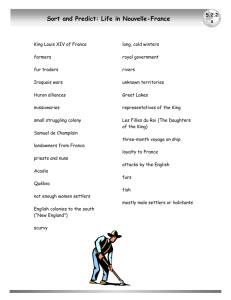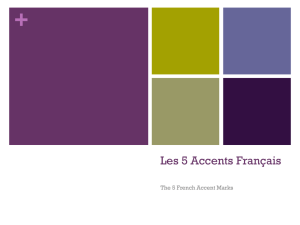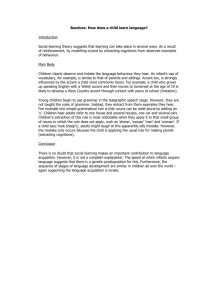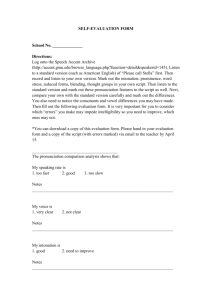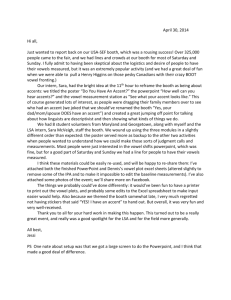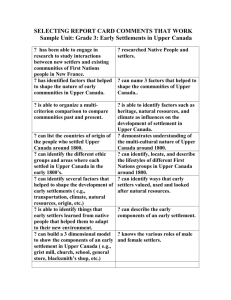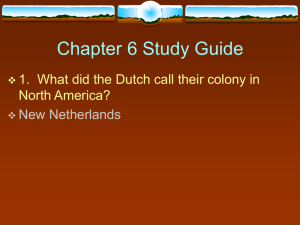American English
advertisement
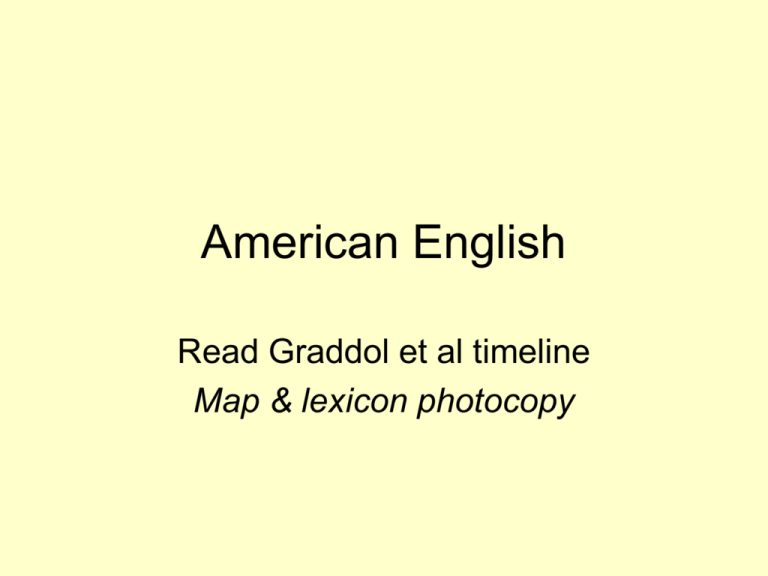
American English Read Graddol et al timeline Map & lexicon photocopy 1584 – failed attempt to settle in the North Roanoke Colony ‘The Lost Colony http://en.wikipedia.org/w iki/Roanoke_Colony • The most significant step in the progress of English towards it’s status as a world language took place when Raleigh went to the ‘New World’. • 1607 – Jamestown Virginia was settled. This settlement was named after King James I and the region was named Virginia after recently deceased Queen Elizabeth (the Virgin Queen). • Then the ‘Pilgrim fathers’ came on the Mayflower and settled in Plymouth Massechusetts. • The southern explorers (Chesapeake) came mainly from the West Country with its ‘Zummerset’ voicing of ‘s’ sounds, and the ‘r’ pronounced after the vowels. In this area the accent can still be heard. They are called ‘Tidewater accents’ and are considered to be the closest to Shakespeare still surviving. Cart, car – Elizabethan English had this feature though present day London has lost it. • The Puritans came mainly from East Anglia and had a different accent – like current modern English they lacked a ‘r’ after vowels. This is still a feature of a New England Acccent. Other features of 17th C English • Are still found in Modern American speech. Short flat ‘a’ – British RP later developed the long ‘a’ – e.g. dance. And later British English pronounces ‘not’ with lip-rounding but in the USA the earlier unrounded vowel ‘nat’ remains. They have kept ‘gotten’ for ‘got’ and ‘eight’ for ‘et’. ‘Mad’ means angry and ‘fall’ means Autumn – semantics have changed in current British English. ‘I guess’ can also be traced back to Middle English. • During the 17th C new ship loads of settlers brought new linguistic backgrounds and the ‘Middle’ Atlantic areas opened up. New York developed rapidly. Pennsylvania was settled by Quakers who were mostly from the Midlands and the North of England. In the early 18th C there was a wave of immigration from Northern Ireland (Scots-Irish)– many in Philadelphia, others went inland. Davy-Crockett was of this descent. The accent was described as ‘broad’. This is the ‘Sunbelt’ accent that we associate with present-day American speech. The three major dialects of the east Coast & Migration • (North) New England moved into the Great Lakes. Began with smallholdings. Say ‘see’. North has tried to Standardize linguistically but South has resisted. Settlers named their settlements after towns and villages in East Anglia. • Southerners moved along the gulf coast and into Texas. Began with rice & cotton plantations. People from South & West England settled here, many had been deported or were political refugees. The labour was slaves. (This is where West African languages started to influence new forms re: Pidgin & Creole.) Say ‘seed’. Values here are older, agricultural, hierarchical and different from mainstream. They enjoy their linguistic difference. • Midlanders spread across the Midwest, across the Mississippi and into California. Native American Influence • Note that Native American, like Celtic, is the language of a conquered people and it has had little influence on American English as Native Americans did not want to mix as servants with settlers…. However the settlers needed some words to describe their new experiences e.g. Racoon – in 1672 this spelling was standardized - comes from Algonquian word ara’kun (‘he scratches with his hands’). Algonquian includes these tribes : Arapaho, Blackfoot, Cheyenne, Cree, Delaware, Fox, Mimac, Ojibwa/Chippewa, Penobscot. This is the only one of many Native American languages that has provided around initially around 150 source words ‘loanwords’ for the colonists. E.g powwow. But their pronunciation has changed from the original. – spellings were changed or the word was incorrectly analysed for meaning. E.g. muskwessu (muskrat). As expansion continued only another 150 were adopted as the Native Americans were hostile but places such as Mississippi and Chattanooga were given native names. Webster felt this was showing respect to the Native Americans. However this did coincide with taking the ownership of the land from the Native Americans. (In England the Celtic names were preserved for rivers…) Early Settler Language & Culture Influence Early settlers also changed the meanings of some English words. E.g. ‘creek’ meant saltwater inlet was changed to mean freshwater stream. English commentators found this ‘barbarous’. • Spanish & Portuguese Late 15th C. (Mexicans, often illegal immigrants speak this) • French Louisiana • New York was originally New Amsterdam (Dutch) • Germans (hamburger) • African-Americans • Italians pizza (food word) • Welsh in Pennsylvania • Jews E.g. Wigwam, Skunk, cookie, chowder, delicatessen, espresso, coyote, kosher etc. Also new words were COINED to reflect the new culture around cattle ranches (cowboy), the railroad (freight), gambling (hit the jackpot), the goldrush (prospecter), and new politics. Noah Webster • Saw English language as corrupted and in decline. He was successful in introducing spelling reforms e.g. color, center, defense, traveller. Also music and logic without ‘k’ succeeded. He was unsuccessful at remaking the final ‘e’ though he tried e.g. ‘medicin’. Webster saw Johnson as ‘class bound’ – Johnson opposed US independence. Webster viewed the Latin, Greek & French origins of owrds in Johnson’s dictionary as elitist. He found Johnson pompous. • There has been a tendency in modern times to encourage diverse cultures to name themselves so ‘negro’ had become ‘African-American’. Lesson 2 Text 3 http://bbqpitboys.com/recipes/hamb urger-recipes As before, prepare your comparison of key constituents for presentation to the class. Phonology (group 1/3) • Vowel change in ‘tomato’ typically associated with American English. • Elision of initial consonant ‘-m’ in ‘them’ is an informal feature which is found in a range of Englishes. • Reduction of vowel sounds is also common in a range of Englishes e.g. ‘and’ reduced to ‘-n’ Grammar (group 2/3) • Use of non-standard demonstrative pronoun ’them’ instead of ‘those’ e.g. ‘toast up them buns’ ‘lock in them juices’. This is a common feature of many English dialects. • Ellipsis of subject/auxialliary verb in some clauses where it is predictable in context e.g. going to move these burgers off’ ‘look good’. This saves time and is a common feature of many varieties of spoken English. Morphology (3/3) • The uninflected adverb ‘real’ is a key morphological feature of American English. Lexis (3/3) • Some limited difference e.g. ‘chuck’ and others which reflect cultural differences e.g. baseball. Discourse/pragmatics (3/3) • The idiolect of the speaker and the informal relationship shown by the frequent use of exclamations, which are stereotypically associated with American English such as ‘man’ ‘boy’. • Work as a pair to write up a paragraph on a key constituent of your choice for presentation to the class. • Gullah Text – research for next week.
